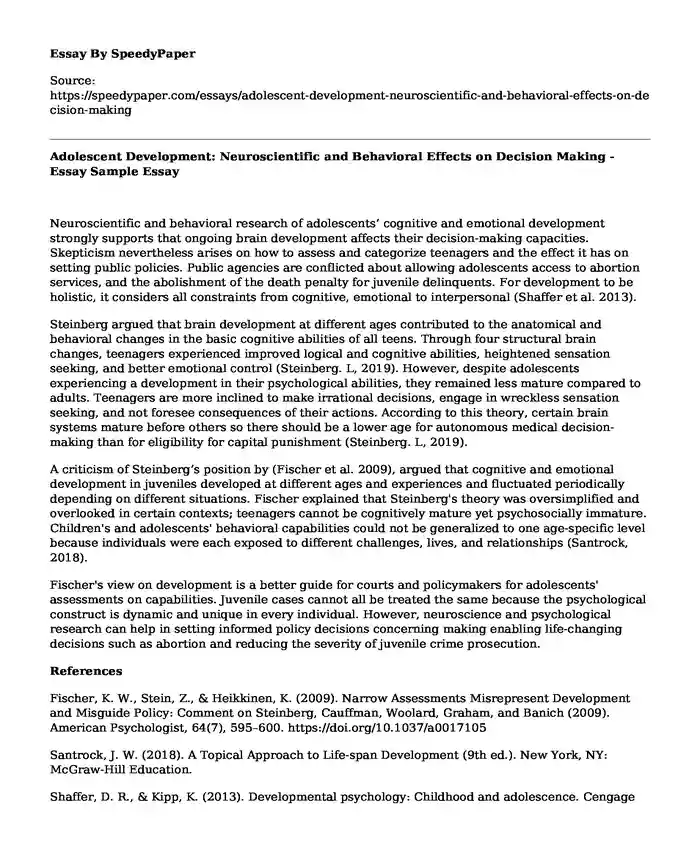Neuroscientific and behavioral research of adolescents’ cognitive and emotional development strongly supports that ongoing brain development affects their decision-making capacities. Skepticism nevertheless arises on how to assess and categorize teenagers and the effect it has on setting public policies. Public agencies are conflicted about allowing adolescents access to abortion services, and the abolishment of the death penalty for juvenile delinquents. For development to be holistic, it considers all constraints from cognitive, emotional to interpersonal (Shaffer et al. 2013).
Steinberg argued that brain development at different ages contributed to the anatomical and behavioral changes in the basic cognitive abilities of all teens. Through four structural brain changes, teenagers experienced improved logical and cognitive abilities, heightened sensation seeking, and better emotional control (Steinberg. L, 2019). However, despite adolescents experiencing a development in their psychological abilities, they remained less mature compared to adults. Teenagers are more inclined to make irrational decisions, engage in wreckless sensation seeking, and not foresee consequences of their actions. According to this theory, certain brain systems mature before others so there should be a lower age for autonomous medical decision-making than for eligibility for capital punishment (Steinberg. L, 2019).
A criticism of Steinberg’s position by (Fischer et al. 2009), argued that cognitive and emotional development in juveniles developed at different ages and experiences and fluctuated periodically depending on different situations. Fischer explained that Steinberg's theory was oversimplified and overlooked in certain contexts; teenagers cannot be cognitively mature yet psychosocially immature. Children's and adolescents' behavioral capabilities could not be generalized to one age-specific level because individuals were each exposed to different challenges, lives, and relationships (Santrock, 2018).
Fischer's view on development is a better guide for courts and policymakers for adolescents' assessments on capabilities. Juvenile cases cannot all be treated the same because the psychological construct is dynamic and unique in every individual. However, neuroscience and psychological research can help in setting informed policy decisions concerning making enabling life-changing decisions such as abortion and reducing the severity of juvenile crime prosecution.
References
Fischer, K. W., Stein, Z., & Heikkinen, K. (2009). Narrow Assessments Misrepresent Development and Misguide Policy: Comment on Steinberg, Cauffman, Woolard, Graham, and Banich (2009). American Psychologist, 64(7), 595–600. https://doi.org/10.1037/a0017105
Santrock, J. W. (2018). A Topical Approach to Life-span Development (9th ed.). New York, NY: McGraw-Hill Education.
Shaffer, D. R., & Kipp, K. (2013). Developmental psychology: Childhood and adolescence. Cengage Learning.
Steinberg. L. (2019, January 23). Should the Science of Adolescent Brain Development Inform Public Policy? | Issues in Science and Technology. Issues in Science and Technology. https://issues.org/steinberg/
Cite this page
Adolescent Development: Neuroscientific and Behavioral Effects on Decision Making - Essay Sample. (2023, Nov 15). Retrieved from https://speedypaper.net/essays/adolescent-development-neuroscientific-and-behavioral-effects-on-decision-making
Request Removal
If you are the original author of this essay and no longer wish to have it published on the SpeedyPaper website, please click below to request its removal:
- Essay Sample on the Vitality of Surfactant to the Infants
- Free Essay Sample on Extracellular Vesicles
- Essay Sample Describing Lifespan Human Motor Development
- Essay Sample on Protocol for Determining if the Cause of the Incident is Criminal
- Essay on Achieving Food Security: Exploring Biosystems and Agricultural Engineering at the PhD Level
- Essay Sample on Research Method and Design
- Biological Sexuality Signaling - Essay Sample
Popular categories





